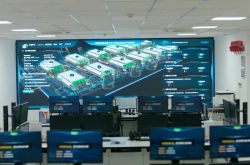What Are the Distinctions Between the Perception Systems of Autonomous Driving and Embodied Intelligence?
![]() 11/10 2025
11/10 2025
![]() 377
377
On November 5, 2025, XPENG Motors officially unveiled its 'IRON' humanoid robot, drawing widespread attention across the industry due to its remarkably human-like gait and seamless motion control. As a relatively new entrant in automotive manufacturing, XPENG's move not only pushes the boundaries of its technological capabilities but also highlights the profound interconnection between autonomous driving and embodied intelligence in their technological evolution. Despite sharing high similarities in the foundational frameworks of perception, decision-making, and control, notable systemic differences persist, particularly at the perception level.

Similarities in Perception
Before delving deeper into the comparisons, it is crucial to clarify the concepts of 'autonomous driving' and 'embodied intelligence.' Autonomous driving pertains to vehicles that perceive, make decisions, and control their movements within road environments to achieve safe and reliable travel from point A to point B. In contrast, embodied intelligence refers to intelligent agents with physical bodies that interact with their environment to perceive, learn, and act. Its scope is broader, encompassing service robots, handling robots, and intelligent agents equipped with a variety of sensors and limbs. Both necessitate 'understanding the world' at the perception level, yet they differ significantly in their starting points, constraints, and technological focuses.
Whether in autonomous vehicles or embodied intelligent robots, the tasks of their perception systems are analogous: converting raw data collected by sensors such as cameras and LiDAR into environmental information that computers can comprehend and utilize. In this process, both heavily rely on multi-modal data acquisition and fusion, adopting data-driven technological routes to achieve target detection, segmentation, tracking, and semantic understanding of scenes. Presently, mainstream deep learning technologies, including convolutional networks, Transformers, temporal models, and attention mechanisms, have become common tools for extracting key features from data such as images and point clouds.
Moreover, quantifying and articulating the uncertainty of perception results is a pivotal shared challenge for both. Systems must not only ascertain 'what lies ahead' but also provide metrics such as confidence levels for judgments, error margins for detection boxes, and even clearly communicate this uncertainty to subsequent prediction and planning modules. Consequently, issues like uncertainty modeling, temporal information fusion, data association, recognition of unknown category samples, and online adaptive learning are all technological hurdles that both must surmount. Their development processes are also highly congruent, involving stages such as data collection, annotation, self-supervised learning, model training, simulation and offline testing, online small-scale validation, and ultimately, large-scale deployment.

Differences in Perception
Although the two overlap in technological foundations, they fundamentally differ in the essential questions of 'why perceive' and 'what to do after perceiving,' leading to vastly different priorities in design and implementation.
The perception tasks of autonomous driving are highly concentrated on 'safety' and 'certainty.' Vehicles need to determine which lane they are in, whether there are vehicles ahead, and whether pedestrians intend to cross, among other things. All outputs must meet exceedingly high reliability standards with minimal tolerance for errors. This implies that its perception system adheres to stringent standards in areas such as redundancy design, sensor reliability, time synchronization, hard real-time performance, and functional safety (e.g., compliance with ISO 26262/ASIL standards). In essence, autonomous driving perception not only strives for high accuracy but also must be explainable, verifiable, and controllable in rare yet perilous extreme scenarios.
Conversely, embodied intelligence perception places greater emphasis on 'adaptability' and 'interaction capabilities.' For instance, a home service robot may not require centimeter-level lane line positioning but must comprehend the graspability of objects, tactile feedback when approaching objects, and how to explore and learn in complex home environments. Embodied intelligence underscores a closed-loop cycle of 'perception-action-perception,' where perception results directly drive exploration and learning strategies, and the system actively adjusts sensor perspectives or body postures to acquire more valuable information (i.e., active perception). Hence, embodied intelligence focuses more on self-body perception, tactile/force sensing, multi-joint state estimation, interactive learning, and the ability to learn swiftly from a limited number of interactions.
From a data perspective, autonomous driving primarily relies on pre-installed sensors (e.g., onboard cameras, LiDAR, millimeter-wave radar) and possesses vast amounts of vehicle-road scenario data. In contrast, embodied intelligence data is more fragmented and scarce, necessitating the online generation of training samples through real interactions or extensive interactive training in simulators.

Where Do Their Technological Priorities Lie?
Autonomous driving prioritizes 'safety, stability, and verifiability'; embodied intelligence places greater importance on 'versatility, interactivity, and learning capabilities.' In autonomous driving perception, the emphasis is on mitigating single-point failure risks through multi-sensor redundancy, achieving stringent time synchronization and calibration to ensure data consistency, combining positioning with high-definition maps for reliable localization, constructing low-latency, high-reliability detection and tracking pipelines, and devising safety strategies for abnormal or unknown scenarios (e.g., degradation handling, safe stops). Technologies such as bird's-eye view representation, sensor geometric correction, motion compensation, point cloud de-warping, radar multipath and Doppler information utilization, and sensor fusion strategies are frequently discussed in the autonomous driving industry. Additionally, explainability, observability, functional safety, and formal verification are also paramount in automotive-grade systems.
Embodied intelligence perception, however, places greater emphasis on online learning and interaction mechanisms, including how to construct task-driven representations, how to utilize self-supervised learning to extract useful features from large-scale unlabeled data, how to design active exploration strategies to enhance sample efficiency, how to conduct large-scale interactive training in simulators and narrow the Sim-to-Real gap, and how to integrate multimodal information such as language, vision, and touch into a unified world model or graspability model to support complex operations. Embodied intelligence also relies more on technologies like reinforcement learning, meta-learning, few-shot learning, and model-based planning to achieve rapid adaptation to new tasks through interactions.

Why Can Automotive Companies More Easily Deploy Certain Capabilities of Embodied Intelligence?
Given that embodied intelligence leans more toward robotics, why are automotive companies better positioned to implement it? A car itself is a mobile 'embodied platform' equipped with a variety of sensors and actuators. Vehicles possess high-quality positioning systems, inertial measurement units, wheel odometers, cameras, radar, LiDAR (in some models), drive-by-wire steering and braking, etc., which constitute the core physical elements required for robots. Compared to developing humanoid or household robots from scratch, automotive companies have more mature hardware platforms, robust sensor procurement and integration capabilities, and extensive real-time vehicle control experience.
Automakers also possess large-scale real data and fleet operation capabilities. Many learning methods in embodied intelligence necessitate vast amounts of interactive data for training or fine-tuning, and automotive manufacturers' fleets (including test vehicles, mass-produced vehicles, and connected vehicles) can provide stable data collection channels, enabling rapid collection of rare scenarios, edge cases, and long-term operational data in real environments—an advantage that small laboratory robots cannot match.
Automakers excel in engineering and safety pipelines. Deploying learning models onto vehicles is not as straightforward as embedding them into electronic control units; it requires a series of processes, including functional safety assessments, redundancy design, online monitoring, OTA upgrade procedures, and supply chain management. Automakers already have mature processes in these areas, enabling them to gradually incorporate new embodied intelligence functions into automotive-grade workflows.
From an economic motivation and ecological synergy perspective, the automotive industry chain includes numerous component suppliers, perception and computing module suppliers, cloud services, and mapping companies. This allows automakers to horizontally leverage existing technologies or swiftly implement new capabilities through collaborations when integrating them. Rather than constructing a general-purpose home robot platform from scratch, grafting embodied intelligence concepts onto automotive platforms that already possess 'bodies' offers clearer commercial returns and more straightforward regulatory pathways.

Final Thoughts
Autonomous driving and embodied intelligence share profound similarities in perception technologies but differ significantly in implementation priorities and system constraints. Autonomous driving emphasizes reliability, redundancy, and verifiability, excelling at transforming complex systems into operable products under engineering control. Embodied intelligence, on the other hand, focuses on interaction capabilities, online learning, and task generalization, excelling at co-learning with the environment through physical actions in uncertain open environments. These two technological paths may appear to diverge, but they are, in fact, mirror images of each other.
-- END --







